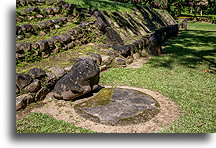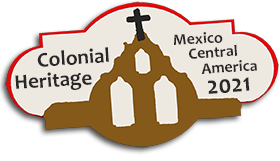A city from 2,800 years ago
November 30




The morning found us in the Takalik Maya Lodge. Beautiful green garden between the coffee plantations fields. It was like an outdoor perfumery with different smells around. Lots of flowers and cocoa fruits on trees around the place where we spent the night. The local restaurant was fantastic for breakfast. There are not many places like this in Central America. At the beginning of the day, we had a short walk to the small waterfall. On the way, we met women harvesting coffee cherries. Guatemalan coffee is one of the best. When we returned, we found a typical Guatemalan chicken bus parked nearby. What a beauty! It was one of those monsters that have tens of LED halogen lights installed in the front. After dark, we are not sure how to navigate on the road when such illuminated sphere approaches from the opposite direction.




We were an hour drive from the Mexican border, but wanted to see the Tak'alik Ab'aj ruins before we left. This site has had a lot of research, archaeologists agree that this place had a continuous settlement history from 800 BC until AD 1200. The changing architectural styles and iconography of Takaliku Abaj suggest that it was a place inhabited by various ethnic groups. In the Middle Preclassic period (800–300 BC), the population may have been associated with the Olmec culture of the Gulf Coast lowlands region. In the Late Preclassic period (300 BC – AD 250), Maya styles begin to dominate with fading Olmec elements. This was probably a shift accompanied by an influx of ethnic Maya population.



Takalik Abaj is unique because Maya hieroglyphic inscriptions here are among the earliest in the entire Mayan region. Characteristic of the Pacific lowlands, the potbelly style of sculpture—very similar to those at Monte Alto—began to appear here around AD 300. The potbellies are not known in Maya art outside this region.



It is the site of the most sculptured monuments found in the entire Pacific lowlands and one of the largest concentrations of Olmec-style carvings outside the Gulf of Mexico. It is interesting that some of the colossal heads have been reworked to achieve a different artistic expression. There are also finds indicating contact with Teotihuacan, a metropolis 1000 km / 600 mi away, which at one point conquered Takalik Abaj.


The city flourished in the Preclassic and Classic periods, from the 9th century BC through to at least the 10th century AD, and was an important center of commerce. After AD 1200 original inhabitants slowly abandoned the city, that they had occupied for almost two millennia.



At Tak'alik Ab'aj, archaeologists have discovered not only platforms and sculptures. This town had stone canals used as a drainage system for major structures. Many tombs have been discovered here, one of which is the oldest royal burial place in the entire Maya world. There is also evidence of monuments arranged in rows that served as an astronomical observatory. Two thousand years ago, the inhabitants of this city watched the celestial sphere to create their concept of the relationship between humans, the earth and the universe.









